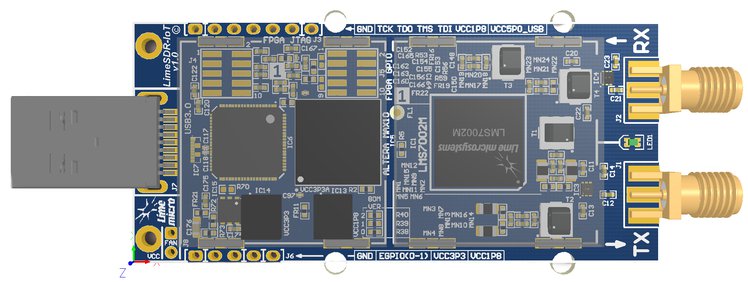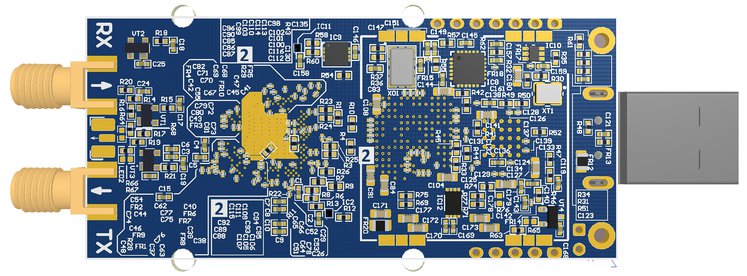A Software Defined Radio for Everyone
LimeSDR is a low cost, open source, apps-enabled (more on that later) software defined radio (SDR) platform that can be used to support just about any type of wireless communication standard. LimeSDR can send and receive UMTS, LTE, GSM, LoRa, Bluetooth, Zigbee, RFID, and Digital Broadcasting, to name but a few.While most SDRs have remained in the domain of RF and protocol experts, LimeSDR is usable by anyone familiar with the idea of an app store - it’s the first SDR to integrate with Snappy Ubuntu Core. This means you can easily download new LimeSDR apps from developers around the world. If you’re a developer yourself, you can share and/or sell your LimeSDR apps through Snappy Ubuntu Core as well.
The LimeSDR platform gives students, inventors, and developers an intelligent and flexible device for manipulating wireless signals, so they can learn, experiment, and develop with freedom from limited functionality and expensive proprietary devices.
From Radio Astronomy to Personal Telcos
Here are just some of the applications that are possible with the LimeSDR:- Radio astronomy
- RADAR
- 2G to 4G cellular basestation
- Media streaming
- IoT gateway
- HAM radio
- Wireless keyboard and mice emulation and detection
- Tire pressure monitoring systems
- Aviation transponders
- Utility meters
- Drone command and control
- Test and measurement
- Many more…
Comparisons
HackRF
One
|
Ettus
B200
|
Ettus
B210
|
BladeRF
x40
|
RTL-SDR
|
LimeSDR
|
|
|---|---|---|---|---|---|---|
Frequency
Range
|
1MHz-6GHz
|
70MHz-6GHz
|
70MHz-6GHz
|
300MHz-3.8GHz
|
22MHz-2.2GHz
|
100kHz-3.8GHz
|
RF
Bandwidth
|
20MHz
|
61.44MHz
|
61.44MHz
|
40MHz
|
3.2MHz
|
61.44MHz
|
Sample
Depth
|
8
bits
|
12
bits
|
12
bits
|
12
bits
|
8
bits
|
12
bits
|
Sample
Rate
|
20MSPS
|
61.44MSPS
|
61.44MSPS
|
40MSPS
|
3.2MSPS
|
61.44MSPS
(Limited by USB 3.0 data rate)
|
Transmitter
Channels
|
1
|
1
|
2
|
1
|
0
|
2
|
Receivers
|
1
|
1
|
2
|
1
|
1
|
2
|
Duplex
|
Half
|
Full
|
Full
|
Full
|
N/A
|
Full
|
Interface
|
USB
2.0
|
USB
3.0
|
USB
3.0
|
USB
3.0
|
USB
2.0
|
USB
3.0
|
Programmable
Logic Gates
|
64
macrocell CPLD
|
75k
|
100k
|
40k
(115k avail)
|
N/A
|
40k
|
Chipset
|
MAX5864,
MAX2837, RFFC5072
|
AD9364
|
AD9361
|
LMS6002M
|
RTL2832U
|
LMS7002M
|
Open
Source
|
Full
|
Schematic,
Firmware
|
Schematic,
Firmware
|
Schematic,
Firmware
|
No
|
Full
|
Oscillator
Precision
|
+/-20ppm
|
+/-2ppm
|
+/-2ppm
|
+/-1ppm
|
?
|
+/-1ppm
initial, +/-4ppm stable
|
Transmit
Power
|
-10dBm+
(15dBm @ 2.4GHz)
|
10dBm+
|
10dBm+
|
6dBm
|
N/A
|
0
to 10dBm (depending on frequency)
|
Price
|
$299
|
$686
|
$1,119
|
$420
($650)
|
~$10
|
$299
($289 pre-order)
|
LimeSDR Mini | ||||||||||||||||||||||||||||||||||||||||||||||||||||||||||||||||||||||||||||||||||||||||||||||||||||||||||||||||||||||||||||||
The LimeSDR Mini development board is a hardware platform for
developing and prototyping high-performance and logic-intensive
digital and RF designs that use Altera’s MAX 10 FPGA and Lime
Microsystems’ LMS7002M RF transceiver.
Render of the LimeSDR Mini

Top render of LimeSDR Mini

Bottom render of LimeSDR MIni
LimeSDR vs LimeSDR MiniThe LimeSDR and LimeSDR Mini are members of the same family of software-defined radios. One does not replace the other. Rather, they are complementary.Simply put, the LimeSDR Mini is a smaller, less expensive version of the original LimeSDR. However, it still packs a punch - at its core, the LimeSDR Mini uses the same LMS7002M radio transceiver as its big sibling. The Mini has two channels instead of four, and, by popular demand, SMA connectors instead of micro U.FL connectors. Check out the comparison table below for more details. Features & Specfications
Block DiagramComparison Table
AccessoriesEnclosure
Prototype LimeSDR MIni and acrylic case
Antennasomni-directional antennas with SMA connectors, optimized for frequency ranges of 800-960 MHz, 1710-2170 MHz, and 2400-2700 MHz. These are the same same antennas used with the full-size LimeSDR.
LimeSDR Mini antennas with SMA connectors
Free & Open SourceAs with the original LimeSDR, the LimeSDR Mini is a free and open source project made in collaboration with the Myriad-RF project. We will be releasing code, firmware, schematics, layout, and associated project files shortly.LimeSuiteThe LimeSDR Mini uses the same host-side software, called LimeSuite, as the full-size LimeSDR. LimeSuite is entirely open source and supports a variety of software-defined radios. You can learn more about LimeSuite at its GitHub repository and Myriad-RF project page.Snappy Ubuntu CoreA big part of the LimeSDR ecosystem is the Snappy Ubuntu Core app store being developed jointly with Canonical and the LimeSDR community. Because the LimeSDR and LimeSDR Mini use the same drivers and APIs, the snaps developed for one should work equally well for the other so long as they are within the operating specification.The working prototype shown in the images below has MMCX connectors - the final version will have two SMA connectors and a U.FL connector for external clock input. 
LimeSDR Mini prototype. The final version will have two SMA connectors and a U.FL external clock connector.

LimeSDR Mini prototype. The final version will have two SMA connectors and a U.FL external clock connector.

LimeSDR Mini prototype. The final version will have two SMA connectors and a U.FL external clock connector.
| ||||||||||||||||||||||||||||||||||||||||||||||||||||||||||||||||||||||||||||||||||||||||||||||||||||||||||||||||||||||||||||||
source:www.crowdsupply.com



Comments
Post a Comment